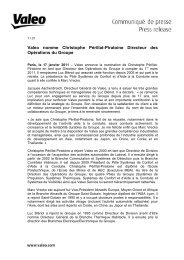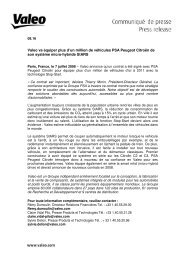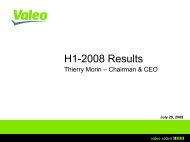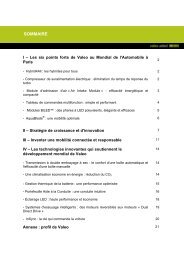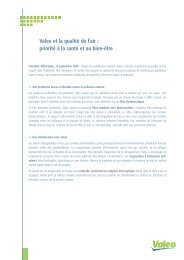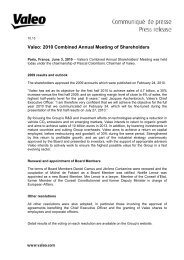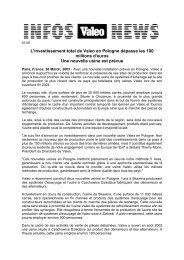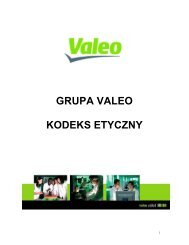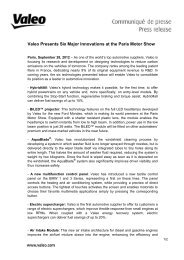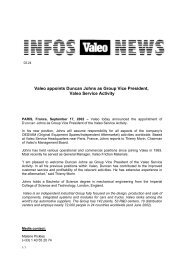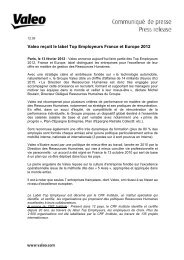2007 Reference document (PDF) - Valeo
2007 Reference document (PDF) - Valeo
2007 Reference document (PDF) - Valeo
Create successful ePaper yourself
Turn your PDF publications into a flip-book with our unique Google optimized e-Paper software.
3 Consolidated<br />
PAGE 88<br />
fi nancial statements at December 31, <strong>2007</strong><br />
Notes to consolidated financial statements<br />
1.7. Financial income and expenses<br />
Financial income and expenses are comprised of the cost of net debt<br />
and other financial income and expenses.<br />
The cost of net debt corresponds to interest paid on debt less interest<br />
earned on cash and cash equivalents.<br />
Other financial income and expenses notably include:<br />
■ gains and losses on currency and interest rate hedges;<br />
■ foreign exchange gains and losses on transactions that do not<br />
meet the definition of hedges under IAS 39 “Financial Instruments:<br />
Recognition and Measurement”;<br />
■ charges to provisions for credit risk as well as the cost of credit<br />
insurance;<br />
■ the effect of unwinding discounts on provisions, including the<br />
discount on provisions for pensions and other employee benefits,<br />
to reflect the passage of time; and<br />
■ the expected return on pension and other employee benefit plan<br />
assets.<br />
1.8. Earnings per share<br />
Basic earnings per share are calculated by dividing consolidated net<br />
income by the weighted average number of shares outstanding during<br />
the year, excluding the average number of shares held in treasury<br />
stock.<br />
Diluted earnings per share are calculated by including equity<br />
instruments such as stock options and convertible bonds, when such<br />
instruments have a dilutive potential effect, which is particularly the<br />
case for stock options when their exercise price is below the market<br />
price (average <strong>Valeo</strong> share price over the year). When funds are<br />
received on the exercise of these rights (such as on the subscription<br />
of shares), they are deemed to be allocated in priority to the purchase<br />
of shares at market price. This calculation method – known as the<br />
treasury stock method – serves to determine the “unpurchased”<br />
shares to be added to the shares of common stock outstanding for the<br />
purposes of computing the dilution. When funds are received at the<br />
date of issue of dilutive instruments (such as for convertible bonds),<br />
net income is adjusted for the net-of-tax interest savings which would<br />
result from the conversion of the bonds into shares.<br />
1.9. Business combinations<br />
All identifiable assets acquired and liabilities and contingent liabilities<br />
assumed, are recognized at their fair value at the date of transfer<br />
of control to the Group (acquisition date), independently of the<br />
recognition of any minority interests.<br />
<strong>2007</strong> <strong>Reference</strong> <strong>document</strong> - VALEO<br />
The cost of a business combination is equal to the acquisition price,<br />
plus any costs directly attributable to the acquisition. Any excess of<br />
the acquisition cost over the fair value of the net assets acquired and<br />
liabilities and contingent liabilities recognized, is recorded in assets as<br />
goodwill. Goodwill is not amortized but is tested for impairment at<br />
least once a year.<br />
Adjustments to the fair value of assets and liabilities acquired or<br />
assumed within the scope of business combinations and accounted for<br />
on a provisional basis (i.e., pending expert appraisals or complementary<br />
analyses) are recognized as a retrospective adjustment to goodwill<br />
if they occur within 12 months of the acquisition date. Adjustments<br />
made after the initial accounting is complete are taken directly to<br />
income unless they correct an accounting error.<br />
1.10. Intangible assets<br />
< Contents ><br />
Innovation can be analyzed as either research or development.<br />
Research is planned investigation undertaken with the prospect of<br />
gaining new scientific or technical knowledge and understanding.<br />
Development is the application of research findings with a view to<br />
creating new products, before the start of commercial production.<br />
Research costs are recognized in expenses in the year they are<br />
incurred.<br />
Development expenditure is capitalized where the Group can<br />
demonstrate:<br />
■ that it has the intention, and the technical and financial resources<br />
to complete the development;<br />
■ that the intangible asset will generate future economic benefits;<br />
and<br />
■ that the cost of the intangible asset can be measured reliably.<br />
Capitalized development costs therefore correspond to projects<br />
for specific customer applications that draw on approved generic<br />
standards or technologies already applied in production. These projects<br />
are analyzed on a case-by-case basis to ensure they meet the criteria<br />
for capitalization as described above.<br />
Capitalized development costs are amortized over a maximum period<br />
of four years from the start of volume production. Impairment losses<br />
may, as required, be recognized in respect of capitalized development<br />
costs.<br />
Other intangible assets are carried at cost less any amortization and<br />
impairment losses recognized. They are amortized on a straight-line<br />
basis over their expected useful lives.<br />
Intangible assets are tested for impairment using the methodology<br />
described in note 1.12.<br />
1<br />
2<br />
3<br />
4<br />
5<br />
6




